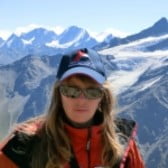
Ice Climbing
BeginnerMountaineering
BasicHiking
BeginnerRock Climbing
BeginnerBackcountry Skiing
BeginnerLuba Pershina
50 years, Russia
ALL YOU NEED TO KNOW TO CLIMB MOUNT ACONCAGUA SAFELY
Aconcagua is also translated with the name of the Guard Stone. And it is, indeed, the closest meaning matching the reality, because often there is very little snow on the mountain, everything is blown away by a hurricane wind and rock walls are inaccessibly suppressed. The western side of Aconcagua is a shear wall, formed by a multitude of towers facing to the sky. You can admire it from the Base Camp, Plaza de Mulas, of the Normal Route.
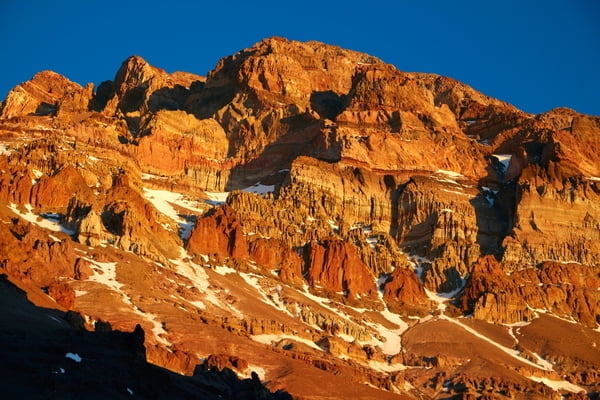
If I were given a free ticket to South America, I would definitely choose Aconcagua as a climbing destination! The incomprehensible combination of some human, natural and spiritual character features with visible and real landscape and geographic-meteorological nature features create a special atmosphere and a kind of mystically positive aura around this mountain. And this is not just my point of view. I know many people who would extend their stay (and someone for the whole season, and every year) at the foot of this Great Mountain, only if finances would permit that. Perhaps, the Base Camp of the Normal Route, Plaza de Mulas, is the reason of it. It really creates a nice atmosphere by making you feel part of the mountain, part of a global "alpine community", no matter your climbing level.
Aconcagua is sometimes called a "trekking mountain," but in the reality, climbing it according to the Normal Route is not a trekking at all. This is a serious high-altitude climb, of course, not technical, but often requires the use of crampons and is complicated by hurricane winds and dry rarefied air.
LEVEL OF DIFFICULTY
According to the international difficulty classification, the Normal Route to climb Mount Aconcagua has a PD level of difficulty. Indeed, the mountain at first sight is quite simple to climb, from a purely technical point of view. There are no such problems as high-altitude complications, even if sometimes, there is deep snow, avalanches, icefalls and ice walls. But if you compare the complexity of Aconcagua with Mount Blanc, a mountain with PD difficulty level as well, established by European standards, then, Mont Blanc is harder to climb. It takes longer and requires much more high-altitude preparation and will require much more energy and effort. However, as I said, officially the difficulty level is low. Because of this, during the climb there can rise problems, such as over evaluated preparation and underestimated climbing difficulty. Consequently, there is a relatively low rate of ascents to the peak: according to official statistics, only 30% of arriving climbers reach the top. Therefore, in my opinion, Mount Aconcagua is not classifiable under any category. This means, you don't need to look for it and don't need to think about it. Just go to the mountain, by keeping calm, happy, wishing to try yourself at altitude in case you don't get to the top. In order to go to Aconcagua without any problem, you must first of all, have a good physical condition and it is better to hire a local guide. Moreover, ask advice to people who already climbed it more than once.
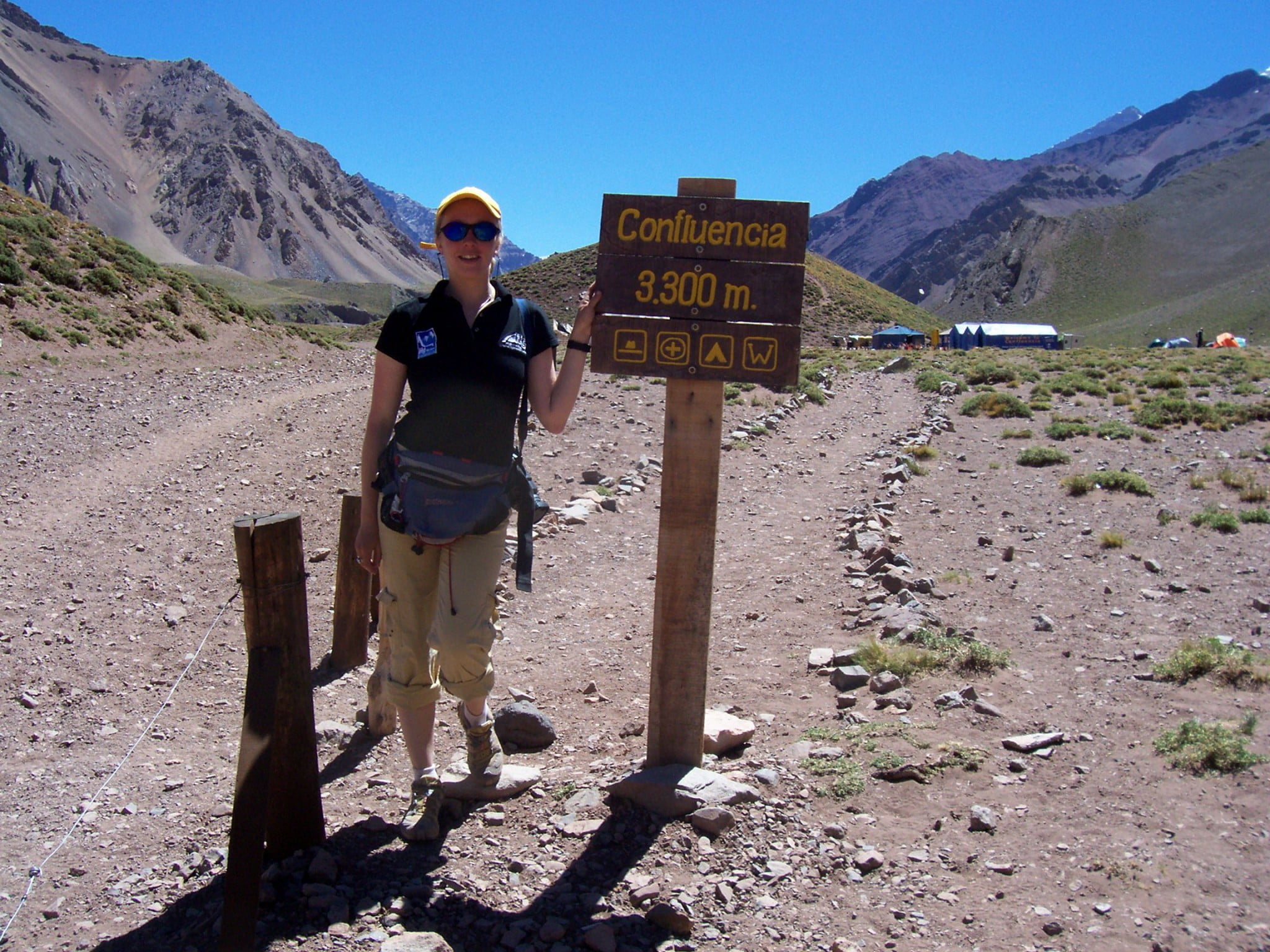
Arriving at Camp Confluencia, 3 300 meters above sea level
The main difficulty of climbing Aconcagua is its dry, rarefied air. It is extremely dry and cold, especially at an altitude above 6000 meters. From a geographical point of view, the mountain locality is called the "high desert". And it is a desert, indeed. It's beautiful, but insidious, as it takes all the liquids from your body. The sun here is your most important enemy, although of course, on a cold mountain it may be helpful. The sun, combined with the cold wind, expel all your fluid supply, dries the skin, the mucous membranes of your nose and throat. At the same time, on the descent from the mountain you have chances to experience 25-degree Celsius heat and you will want to take off everything and spend your last money for a cold coke.
Make sure you drink enough liquids, much more than you would drink normally. According to my experience, I have to double my water consumption (from 1.5 liters normally, to 3 liters daily in Aconcagua), including soups, tea, coffee and other sparse drinks based on water. However, every body behaves differently. In case you drink a lot of liquid normally, water consumption in the mountain can be multiplied by 1.5 and more. The most important thing is to avoid dry mouth feeling and thirst, because this is the first alarm of dehydration! Obviously, consumption of saturated liquids with carbohydrates, such as sports drink powders (such as Gatorade), is extremely useful. But the most important thing is to drink what you like most (excluding alcohol, of course) as much as possible!
Another obstacle while climbing Aconcagua is the constant wind, piercing through, and sometimes throwing you up if you have a light backpack and you are lighter than 60 kg. In order to fight the wind, you need, first of all, comfortable and adequate clothing. While approaching this mountain the weather can change three to four times a day. And the temperature variation can reach up to 30 degrees Celsius during the day (for example, from approaching the Base Camp at the beginning of the route, and at the Base Camp itself). Therefore, one more simple advice: do not save on quality clothes, on the so-called "layers" system, when in just a minute you can remove or put on 2 top layers and feel comfortable, and have the opportunity to actively move at altitude. And without any doubt, the key word here is certainly: Gore-Tex! And of course, a down jacket, and a sleeping bag for the bivouac shelter.
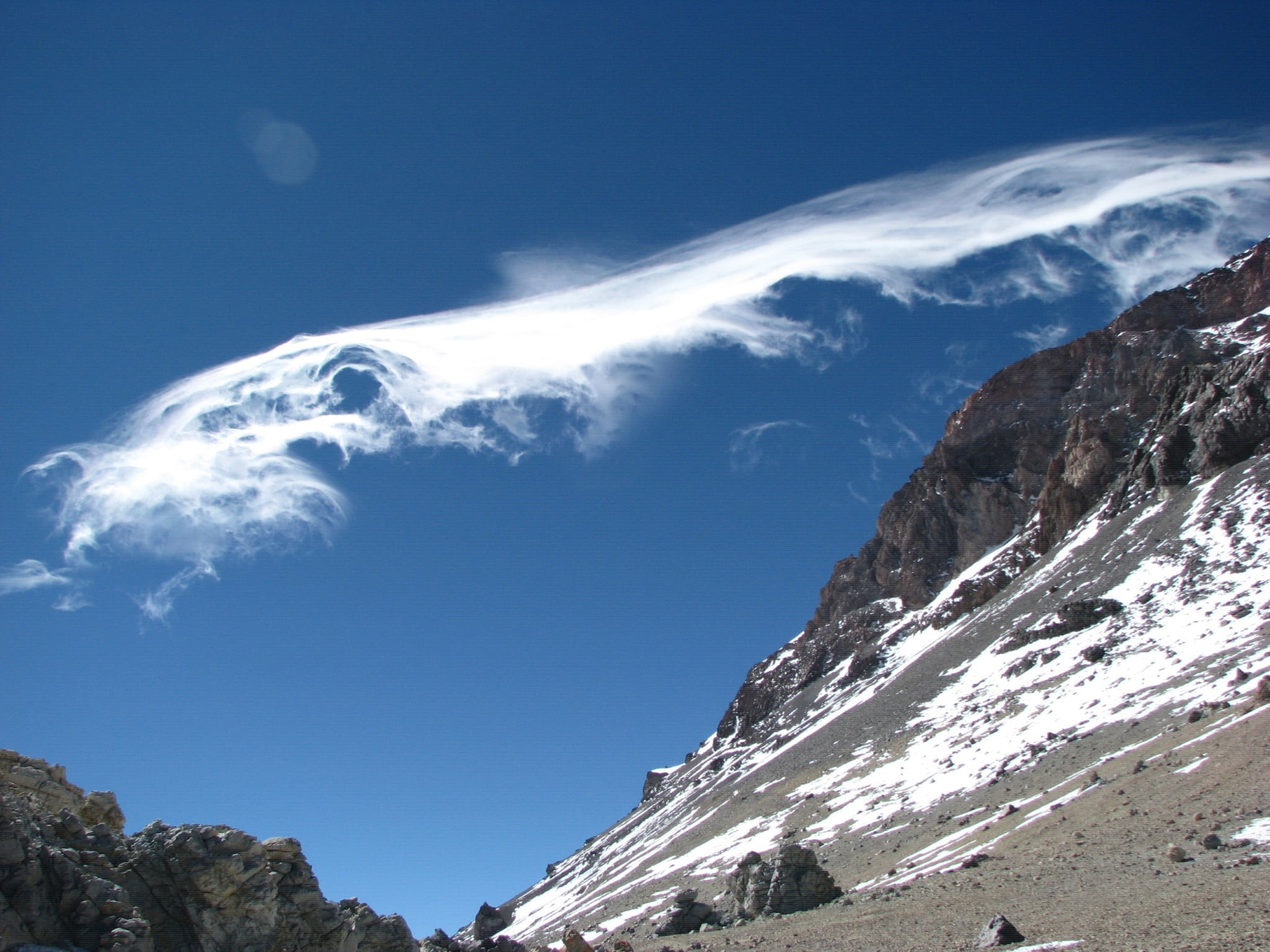
Clouds above Nido de Condores. Photo by Viaxheslav Kurchakov
REQUIRED EXPERIENCE FOR A SUCCESSFUL AND SAFE CLIMB
The hardest difficulty on Aconcagua is altitude, which in combination with the wind and high-altitude air dryness is the main obstacle in order to reach the summit. Adequate altitudinal experience is required in order to overcome this difficulty. This experience consists in estimating properly your physical condition and the ability to regulate your speed on the mountain. It is better to have such climbing experience equal to expeditions exceeding 5000 meters in order to climb Mount Aconcagua safely. It is even better to bring with you such experience of climbs on mountains higher than 6000 meters. Experiencing long high-altitude trekking, with high-altitude overnight stays, for example, in Nepal will also be a great help.
Actually, if you climbed at least two or three times mountains above 5000 meters (such as, Kilimanjaro, Elbrus, or any peaks in Peru and Bolivia), you can go to Aconcagua. Give it a try, because each season the conditions of the mountain and your condition may vary, unlike the experience of your previous ascents. The entire combination of your mountain experience, the wisdom of your guide, a correct weight distribution (which you have to regulate by yourself) with weather and mountain conditions affects the result of the ascent. Make sure you understand that the mountain will always be there while you can come back again, and believe me, you will be always happy to come back to Aconcagua!
HOW TO CHOOSE A TRAVEL AGENCY
Aconcagua has more than 40 tour operators, from giant "monsters" with almost VIP services (such as INKA Expediciones) to individual guides that drive only a few people per season. As I have already mentioned, for a successful and safe climb to Aconcagua it is better to hire local guides. Only local guides know each route weak points, climate features, topography, and can quickly orientate through the mountain dynamic conditions. In addition, they are able to communicate with the Aconcagua National Park (during the last years, communication with the Park became more delicate), with doctors on the route, as well as with mule drivers. By not disposing of all these information, your expedition risks to turn into a real chaos, and you will lose your time and forces later required for climbing.
More than once I saw how those trying to save money on a guide (by hiring their own inexperienced foreign and cheaper guide) on the day of rest and acclimatization rushed to the Base Camp looking for necessary things, services, and so on, that were not included in their cheap expeditionary package. As a result, it is not a very good condition before going up to the high-altitude camp. I spent 7 consequent seasons working on Aconcagua as a guide, and with excellent knowledge of Spanish and excellent contacts with many operators and guides on the mountain, I still do not know many of the nuances that may surge during the expedition and during its preparation. I am sure that it is better to hire directly local, Argentinian, travel agencies and guides.
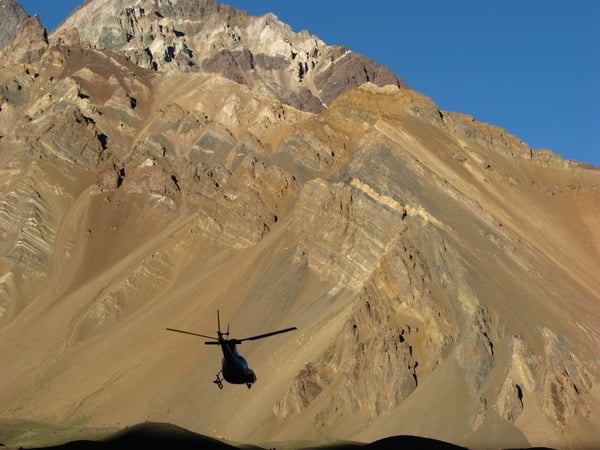
Heli at Aconcagua Base Camp. Photo by Viacheslav Kurchakov
If I were looking for a travel agency or a guide for climbing Aconcagua, I would pay attention, first of all, to how my questions are answered. You can be offered an interesting website, a beautifully written program, with great pictures, a long list of equipment, etc., but in case you have important questions you want to clarify before the arrival, a good guide should reply you by being very specific. In addition, the ideal guide should add extra information, or just ask you if you have other questions. This is an indicator of how the guide will take you to the mountain. The design and the external comfort of their base camp should not be decisive while choosing your mountain guide.
Not always an individual mountain guide will be worse than a big tour operator with a luxury camping equipment. Often an independent guide or with an assistant working just with few customers per season, will focus much more on you, your acclimatization, physical condition, etc., even if you are not served dinner in a beautifully illuminated tent with 24 hours WiFi reception. But in any case, always look exactly at how this guide started to communicate with you and which expedition options you are offered. And of course, if you are looking for a comfortable and funny camp, you can contact large or medium-sized companies (such as Fernando Grajales Expeditions). They work with individual tourists, as well as with large groups. In addition, the experience of your guide on other peaks of the country, South American and around the world, can be important. In this case, you can refer to such famous and experienced guides as Heber Orona tour operator.
THE MOST SUITABLE CLIMBING SEASON
The climbing season on Aconcagua starts at the beginning of November and continues until the middle of March. It is interesting that in the last years the best months for climbing have moved from December - January to the end of February - March. A few years ago, during a season, the best foreign tour operators weren't able to take to the top even one of their participants during the 2-3 best climbing weeks (the last week of December and the first two weeks of January). That year, there was such a wind on the mountain that even the strongest guides and participants had difficulties to get to the Berlin camp (not to talk about the summit!). During that same year, on 9th and 10th of March, it was possible to stay on the top with a fleece jacket and a thin Gore-Tex, and descend on pleasant compacted snow. Imagine that March in this area is already considered as autumn...
The snow flies off (it sweeps away, and it melts under the hot sun) from the mountain surprisingly quickly: in 2 weeks after the snowstorms and 1.5-meter snow, Aconcagua, sometimes, has no signs of it. It is typical to see a snow-covered mountain with strong winds in November, an ideal route with a small comfortable snowfall in December-January, and already dried by the sun and completely without snow, a bare, weathered mountain in late February-March. From now, this scheme is no longer matching the reality as time passes.
Therefore, while choosing the period of your expedition to Aconcagua, it is better to follow your instinct and rely on your own luck. And of course, you need to consider the number of people on the mountain and the permit cost. The largest number of mountain climbers, and mostly the Plaza de Mulas (Base Camp) of the Normal Route is normally open from mid-December to mid-January. If you don’t want to climb surrounded by crowds of climbers, try to avoid arriving on these dates.
Another important factor is the permit to climb the National Park of Aconcagua. Its cost is increasing drastically every year. Some time ago, we used to pay around US$250 per person in the middle season. Now, during this period, Permission for foreigners (not Latin-Americans) costs more than US$700, and in peak season, from December 14 to January 31, US$950. And recently there was a new rule: there is no more low season for permits (it used to be from the beginning - middle of November and from March 1st to 15th). This period is now called winter and climbing during it will cost you US$1200!
Before deciding during which month of the season you want to go to Aconcagua, take a look at the website of the National Park, and it is better to talk to your local operator or guide. The most important thing to know is that you will pay for permit 20% less, if you register at the National Park through a local official operator. Also, any licensed guide and all medium and large size operators in Mendoza have the right to reduce the permit cost of their customers.
HOW MANY DAYS DO I NEED FOR A SUCCESSFUL CLIMB?
The standard duration of the expedition for climbing the Normal Route (Plaza de Mulas) from Mendoza to Mendoza is 17-18 days. Almost all operators in Aconcagua offer this classic program. Usually this program contains standard acclimatization days: at Plaza Confluencia with trekking to Plaza Francia and in the Base Camp of the Plaza de Mulas - at least 2 days of rest at different times; and one or two spare days in case of bad weather.
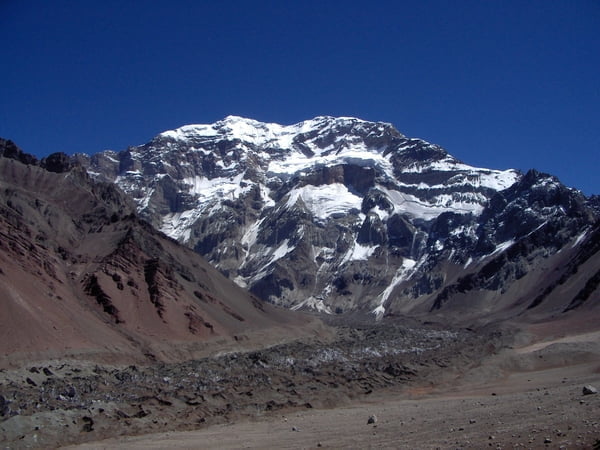
Aconcagua South Face from the trek to Plaza Francia
In addition, basically all operators propose, as a preliminary acclimatization, to spend the night at an altitude of 2700 meters in the town of Penitentes. You can find there the famous alpine hotel, Ayelen as well as Puente del Inca Bridge, where the famous thermal springs are located, and there are also several hotels for mountaineers. And then climbers go up to the first camp along the route: Confluencia 3300 meters. At this altitude they spend 2 nights, which is important for slow accustoming to altitude as 2 days ago you were at sea level.
And one more detail: from this camp, Confluencia, groups usually go for a one-day trekking to an altitude of 4100-4200 meters to the Base camp under the South Wall of Aconcagua, to the so-called Plaza Francia (4200 meters). Some groups do not go further and take a break on a viewpoint at an altitude of about 4100 meters. However, I advise you to visit the base camp under the South Wall. This is also an extra time (about another 1.5 hours round trip) for a good acclimatization, on foot along a practically straight line without an uphill trail. And also, reaching the South Wall is quite impressive and makes you feel strong and victorious. The views from these places are stunning, and the trekking route is beautiful. But most importantly, it is extremely useful for further acclimatization. Therefore, I do not advise you to shorten the program on this piece of the route. And, in addition, I believe that such a program requires at least 18 days (we are talking about climbers with an average climbing experience, and not about athletes with many peaks and expeditions experience).
However, if I went to Aconcagua with a small group of friends or with just one friend, I would certainly take three extra spare days. As you are never sure about the weather and heavy snowfall or strong wind could take place. Snowfall, normally, can stop in 1 or 2 days. But, if strong winds begin to blow on this mountain, then they usually do not end on the next day. According to my memories, the most experienced athletes managed to climb to the top only on the 4th day from the planned days to get to the peak, because of heavy winds. After their ascent, the wind kept blowing for another 3 days.
So, if you still want to go to the top of Aconcagua safely, and appreciate your time, I really advice you to ask your travel agency to add at least 3 spare days to your schedule. This means, the program should last 17 days plus getting from Mendoza to the mountain and then, to Mendoza, or 19 days including the stay in the city. Probably, you will have 2 spare days in the program, but never buy a return plane ticket for the next day after you return to the city! Enjoy the warm Mendoza; otherwise, this 3rd spare day may be very useful.
This is for those people who have limited time because of serious business, strict boss or family circumstances. People having enough time for this expedition and wishing not to return to the mountain again because of not being to climb it due to bad weather, I would recommend a 20-day program, sometimes called the Normal Route Extended. Ask your mountain guide or tour operator to send you this program, and discuss with them the details and possibilities of this option. From the logistic point of view, this program isn't more complicated than the shorter one, and shouldn't be that expensive. However, your costs will pay off while you get to the foot of the beautiful Stone Guard.
ESSENTIAL GEAR
You may take a look at this gear list which consists of 45 items. It was developed for the Normal Route via Plaza de Mulas. However, it is suitable for other similar routes such as Polish Traverse and its variations. To get an access to the list you have to be registered at Mountain Planet.
AND A FEW SMALL, BUT EVENTUALLY IMPORTANT ADVICES:
1. Go for an additional acclimatization to Valecitos, the Base Camp of the small mountain range Cordón del Plata. It is not necessary to climb up to the top of Cerro del Plata (5968 meters); you can just stay 2 nights at the camp at an altitude of 4300 meters and walk a little bit higher. After these 4 days you will feel confident enough on Aconcagua in Plaza de Mulas camp. Your chances of reaching the summit will almost duplicate.
2. Do not rush during the way from Confluencia to the Base Camp of Plaza de Mulas. It may seem easy to you and the altitude makes the climb light. Beware that from the second part of the way, the altitude will suddenly increase, and you may reach the Base Camp too tired. It is better to move slower at such altitudes, even if you don't feel tired. Leave early enough in order to reach Plaza de Mulas before sunset. Don't try to avoid spending the night at Confluencia and reach the Base Camp just 1day earlier! It may have with a bad ending.
3. During the way to Plaza de Mulas, don't carry too much weight in your backpack and try to give as much as possible things to the mules. Take only extremely necessary things to stay at Confluencia, the less possible: warm cloths, headlamp and other small things. If you carry a too heavy backpack during this long way on such a serious climb, 4350 meters altitude at the Base Camp can turn into a nightmare.
4. Don't argue with local doctors who will check your health at both camps: Plaza Confluencia and Plaza de Mulas. In case some of your health indicators aren't so good, and doctors will ask you to wait for ascent and take medication, do not be angry with them and don't be sad. It's their job and duty to protect climbers, and sometimes even save climbers. Your condition will necessarily improve if you won't argue and will take all the measures prescribed by the doctor. Remember that the consuming enough liquids and a balanced acclimatization program are the key for a successful climb.
5. Don't worry if you have stomach problems at Plaza Confluencia. It's the local water, which is clean, but contains some microorganisms that may affect a third part of climbers.
6. It is recommended to avoid the consumption of too heavy food (meat) during the rest days and altitude acclimatization. Of course, at Plaza de Mulas you may have the desire (and it is normal) to dine well, perhaps with some wine. But, if you don't know the reaction of your body to an abundant food and alcohol intake at altitudes above 4000 meters, it is better to avoid experimenting. Leave this pleasant dinner for the evening of the descent from the top, and it will seem to you a gift of the Gods!
7. If you want to socialize with interesting people, make sure you visit the painter, Miguel, living in a light large tent in the center of the upper part of the Base Camp. His art gallery is the highest of the world. Even if you won't be interested in his art, pleasant communication, always up-to-date weather forecast, the cheapest Internet in the camp and a call home can be very useful for you.
8. Here is my last advice. Many will want to know if you can climb Mount Aconcagua alone, without a guide. First of all - climbing alone is not recommended. It is better to go with someone, even if you are an experienced mountaineer. While you can climb without a guide, especially without a tour operator. But, as I said before, without a guide, you will have to pay about 20% more for the permit. You are allowed to climb the mountain without a guide, after you fill a questionnaire (in the office of the National Park) by listing your experience and health condition details. If you get the permit, you can climb the mountain alone. You just need to find a firm that operates with mules to take your things from Plaza de Mulas (I recommend Rudy Parra at Los Puquios). Then take a bus to Puente Inca before entering the Park until you reach Confluencia! Don't try to carry all your things by yourself to the Base Camp! There were cases when brave athletes had problems after such an attempt.
Hope it will help you!

